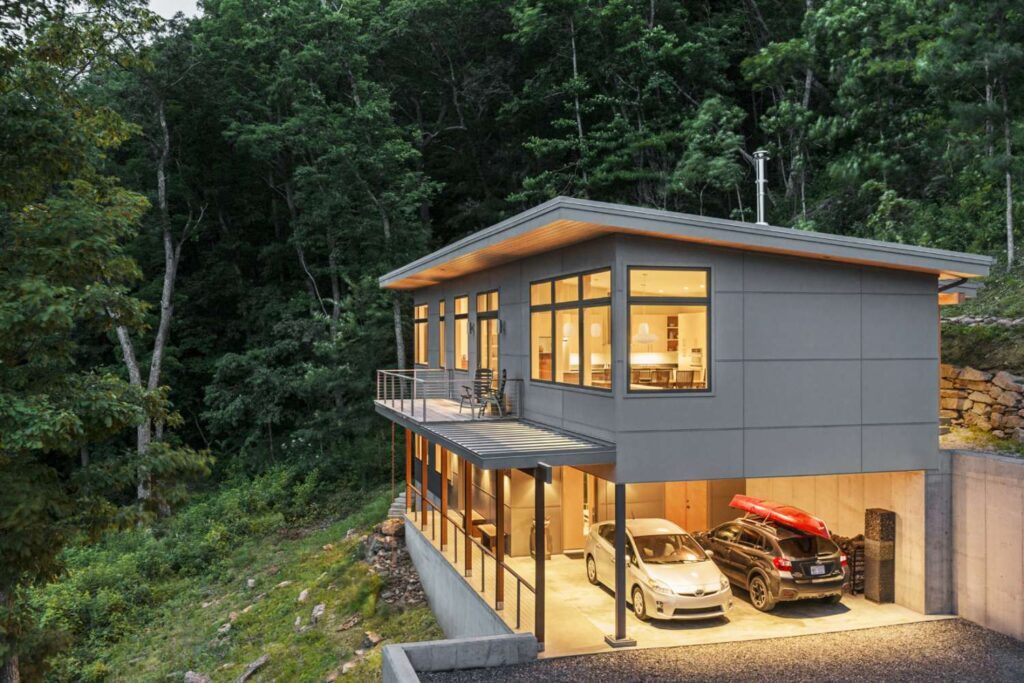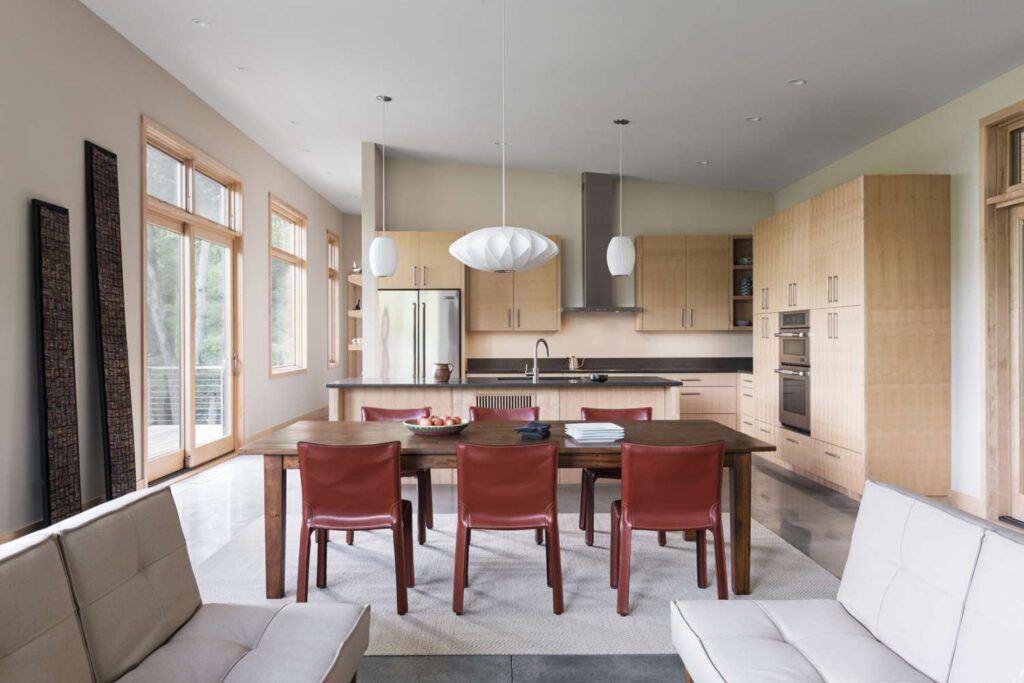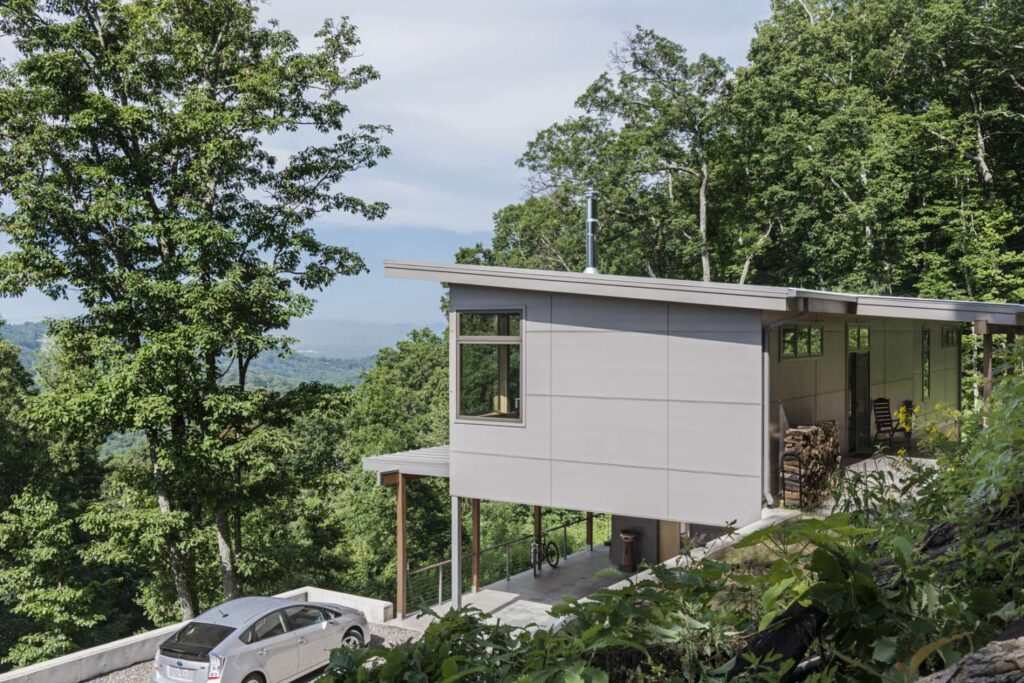Our clients came to us after purchasing five acres of steep mountain land with great views looking down the Beaverdam Valley. Avid hikers and mountain bikers, they bought the land in part because of access to nearby trails and proximity to downtown Asheville. In addition, the south-facing slope allowed them to build the energy-efficient, passive-solar house of their dreams.
Energy efficiency was a major design priority for our clients. The goal was to minimize energy use as much as possible while using cost-effective and conventional building techniques.
Polished concrete slabs are used on both floors to provide the proper thermal mass for passive solar energy, and roof overhang depths were calculated for the correct year-round sun exposure. An efficient thermal envelope, energy recovery ventilator, and mechanical system also minimized energy use and allowed the house to achieve a HERS rating of 50 (50 percent more efficient than a standard new home).
The design process started by studying the character of the land. We explored several site concepts and house layouts that worked within the confines of the steep topography, not against it.

From this process, we developed a narrow floor plan that worked parallel to the land, and minimized retaining walls. This narrow layout allowed for daylight to enter on multiple sides of most rooms – one design strategy for reducing the need for electric lighting. These site factors, combined with a tight budget, led us to a design solution that had a simple and compact footprint and minimized driveway and other site work costs.
The upper level has the best valley and mountain-ridge views, so the main living spaces and master bedroom are located on this floor. The lower level connects to the carport and holds guest bedrooms and an office.
Efficient space planning reduced any wasted square footage and packed a lot of functionality into this 2,100-square-foot house. Outdoor spaces to the north and south flank the main living space, which visually and physically connect the living area to the outdoors. These outdoor spaces offer a variety of shade and sun, depending on the season, as well as a connection to the surrounding landscape and paths around the house.
The house was pre-wired at the time of construction for the homeowners to add on a rooftop mounted photovoltaic solar array. They eventually did install eighteen 285-Watt panels on the roof, giving them a 5.13kW array.

After installing the PV array, our clients began monitoring the home’s energy usage, and quickly realized that it was performing at net-zero levels. They approached us again, this time with the request that we find a way to certify their home as net zero.
As many past Green Building Directories have shown, the net-zero trend is catching on in Western North Carolina. Homeowners, designers, and builders alike are becoming more educated about energy efficiency and are open to taking the extra steps to bring their structures to a carbon-neutral level of operation.
We chose the International Living Future Institute’s Zero Energy Building Certification for this project because they are truly at the forefront of environmental sustainability. From their website, the ILFI is a “non-governmental organization committed to catalyzing a global transformation toward true sustainability.”
Their zero-energy certification is based on actual building performance, not modeled performance, and requires that one hundred percent of a building’s energy needs (on a net annual basis) be supplied by on-site renewable energy. No off-site renewables, offsets, or on-site combustion are allowed, with an exception for fireplaces that contribute to a home’s ambiance.

Their certification submittal process itself is straightforward, but documentation-intensive. The organization requires utility bills showing energy used versus energy produced on-site for a year, and a spreadsheet tabulation of that information. They require a list of all energy-using appliances and a comprehensive electrical diagram showing every energy-using appliance and the power-generating systems installed on-site. In addition to all of this, they require photo-documentation of all appliances, the power-generating systems, and the inverter.
This home was the first project in North Carolina to achieve any level of certification through ILFI, and the first ILFI Zero Energy Building Certified project in North Carolina.
It also has the smallest PV array of any ILFI Zero Energy Building Certified project, showing that thoughtful design is just as important as large solar arrays to achieve zero energy.
Margaret Chandler, AIA, LEED AP, has been at Samsel Architects since 2012. She has worked in sustainable design since earning her degrees at Clemson University, and briefly lived in a treehouse off the grid in Austin, TX. Margaret currently serves on the AIA Asheville Executive Committee as chair of Committee on the Environment.
You can also view this article as it was originally published on pages 18-19 of the 2018-2019 edition of the directory.

